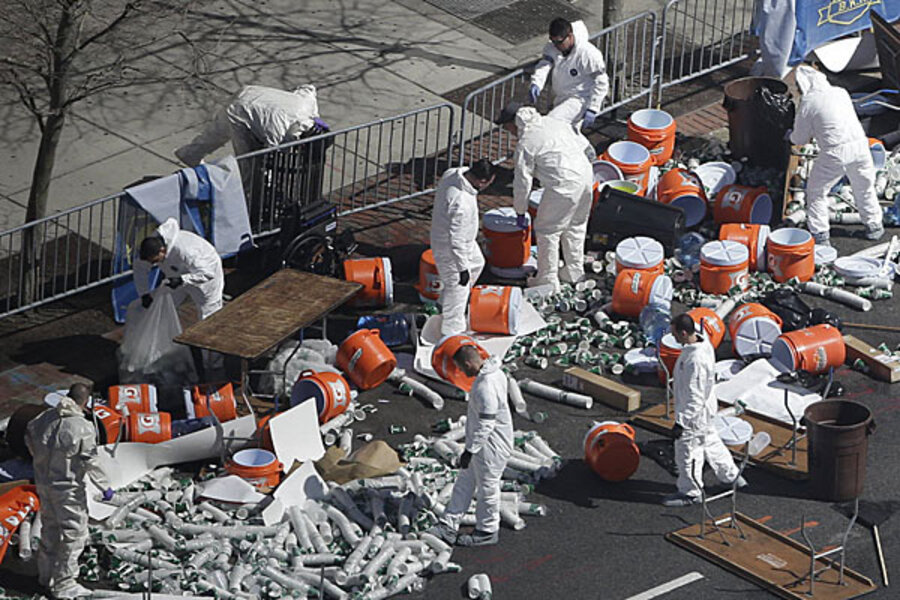Boston bombing suspects? Authorities seek IDs of two men seen on video
Loading...
Three days after the Boston Marathon bombing hundreds of federal investigators are now chasing the name behind a face.
Video security clips from a Lord & Taylor department store across the street from the spot where the second bomb exploded show a man acting suspiciously, according to FBI personnel. He drops a bag and then walks away.
Images show him reacting to the first explosion by quickly exiting the site where the second explosion is about to occur.
“The camera from Lord & Taylor is the best source of video so far,” Dot Joyce, a spokeswoman for Boston Mayor Thomas Menino, told The Boston Globe. “All I know is that they are making progress.”
The person in question is a young white man wearing a black jacket, a gray hooded sweatshirt, and a white or off-white baseball cap on backwards, according to CBS News.
Investigators are now going through logs of cellphone calls line by line, trying to determine who made calls from that location around the time the bombing took place, says CBS. They have cellphone owner information they are trying to match to the elusive face.
CBS correspondent John Miller, a former FBI assistant director, said that on Wednesday federal authorities had decided to release images from the Lord & Taylor video so as to enlist the public in the effort to determine the man’s name. Then they pulled back.
Agents are still assessing whether to go forward with that tactic, said Mr. Miller.
“For investigators, there’s always a difficult choice because if the person doesn’t know you’re looking for him, he may stay in place, you may catch up to him. If he does know you’re looking for him, he may run. On the other hand, if you don’t get him, it’s always great to enlist 20 million or so more eyes in the public who may be able to give you a location right away,” said Miller.
It is possible that this decision was affected by the confusion surrounding the possible arrest of a suspect on Wednesday. Several news outlets, including CNN, Fox News, the AP, and The Boston Globe, reported that such an arrest had been made, citing law enforcement sources. The FBI late in the day issued a statement denying such an arrest and asking for the media to exercise responsibility and restraint in its reporting on the case.
On Thursday, other reports indicated that the FBI is also seeking the identification of a second person captured on video who was seen carrying a backpack and behaving suspiciously in the vicinity of the first person of interest.
The Los Angeles Times reported that “the image that shows two men is the first indication that more than one bomber may have been responsible for the attacks.”
The Wall Street Journal also says that the FBI wants to identify a second person seen in the crowd.
However, such leads do not always pan out, cautions the Journal. In the 2010 failed bombing attempt in New York’s Times Square, investigators asked for public help in identifying a man in a red shirt leaving the scene who was caught in photographic images. It turned out that person had nothing to do with the case.
For investigators, the race to identify the person or persons they’re looking for will involve much more than flipping through old mug shots to see if any match up. Modern facial recognition software can help them speedily look for matches in FBI databases of arrest photos and criminal suspects. In some instances, surveillance cameras in airports and other public locations can even be programmed to look for people with similar features.
Meanwhile, the nation remained on edge in the wake of the Boston Marathon tragedy. An explosion that leveled a fertilizer plant in West, Texas, causing many casualties, added to the sense of American unease.
In Washington, the FBI announced the arrest of a Mississippi man, Paul Kevin Curtis, in the mailing of letters laced with the poison ricin to President Obama and at least one US senator.
President Obama is set to travel to Boston on Thursday for a memorial event for Boston Marathon bombing victims. Part of the city’s Back Bay remained a crime scene, sealed by police barricades.
Massachusetts Gov. Deval Patrick told the AP that he shared the public’s frustration with the fact that no one responsible had yet been caught.
But the case will not be wrapped up by “magic,” he said.
“It’s going to happen by doing the careful work that must be done in a thorough investigation,” said Governor Patrick. “That means going through the couple of blocks at the blast scene inch by square inch and picking up pieces of evidence and following those trails, and that’s going to take some time.”








